
Creative Commons Attribution-Noncommercial-No Derivative Works 3.0
Plates 2.36-2.37: Monument of Raherus and St. Bartholomew's Priory Church (Original Explanatory Account)
1 media/vm1-02-cropped.jpg 2020-07-02T13:57:21+00:00 Ariel Fried f6b6cec26c5a46c3beae9e3505bac9e8799f51de 31 16 Original Explanatory Account for Vetusta Monumenta, Plates 2.36-2.37. Written by Richard Gough. plain 2021-12-25T03:02:54+00:00 Mary-Claire Sarafianos b64b0f9cad2b567cca4c9f2022b28f5bd47876a6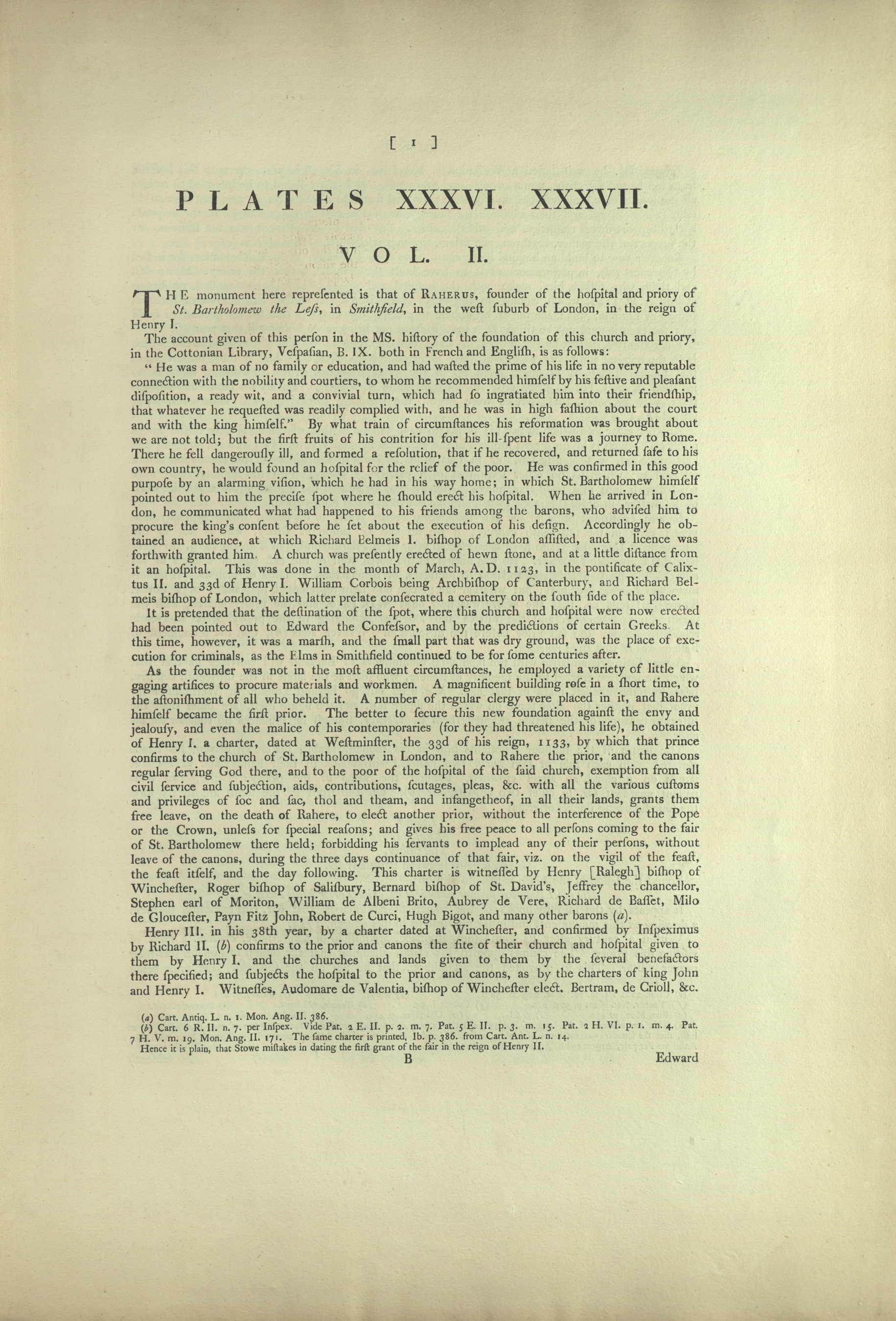
[(Page) 1]
PLATES XXXVI. XXXVII.
VOL. II.
THE monument here repreſented is that of RAHERUS, founder of the hoſpital and priory of St. Bartholomew the Leſs, in Smithfield, in the west suburb of London, in the reign of Henry I.
The account given of this perſon in the MS. hiſtory of the foundation of this church and priory, in the Cottonian library, Veſpaſian, B. IX. both in French and Engliſh, is as follows: “He was a man of no family or education, and had waſted the prime of his life in no very reputable connection with the nobility and couriers, to whom he recommended himself by his feſtive and pleaſant diſpoſition, a ready wit, and a convivial turn, which had ſo ingratiated him into their friendſhip, that whatever he requeſted was readily complied with, and he was in high faſhion about the court and with the king himſelf.” By what train of circumſtances his reformation was brought about we are not told; but the firſt fruits of his contrition for his ill-ſpent life was a journey to Rome. There he felt dangerouſly ill, and formed a reſolution, that if he recovered, and returned ſafe to his own country, he would found an hoſpital for the relief of the poor. He was confirmed in this good purpoſe by an alarming viſion, which he had in his way home; in which St. Bartholomew himſelf pointed out to him the preciſe ſpot where he ſhould erect his hoſpital. When he arrived in London, he communicated what had happened to his friends among the barons, who adviſed him to procure the king’s conſent before he ſet about the execution of his deſign. Accordingly he obtained an audience, at which Richard Belmeis I. biſhop of London aſſiſted, and a licence was forthwith granted him. A church was preſently erected of hewn ſtone, and add at a little diſtance from it an hoſpital. This was done in the month of March, A.D. 1123, in the pontificate of Calixtus II. and 33d of Henry I. William Corbois being Archbiſhop of Canterbury, and Richard Belmeis biſhop of London, which latter prelate conſecrated a cemitery on the ſouth ſide of the place.
It is pretended that the deſtination of the ſpot, where this church and hoſpital were now erected had been pointed out to Edward the Confeſſor, and by the predictions of certain Greeks. At this time, however, it was a marſh, and the ſmall part that was dry ground, was the place of execution for criminals, as the Elms in Smithfield continued to be for ſome centuries after.
As the founder was not in the moſt affluent circumſtances, he employed a variety of little engaging artifices to procure materials and workmen. A magnificent building roſe in a ſhort time, to the aſtoniſhment of all who beheld it. A number of regular clergy were placed in it, and Rahere himſelf became the firſt prior. The better to ſecure this new foundation againſt the envy and jealouſy, and even the malice of his contemporaries (for they had threatened his life), he obtained of Henry I. a charter, dated at Weſtminſter, the 33d of his reign, 1133, by which that prince confirms the church of St. Bartholomew in London, and to Rahere the prior, and the canons regular ſerving God there, and to the poor of the hoſpital of the ſaid church, exemption from all civil ſervice and ſubjection, aids, contributions, ſcutages, pleas, &c. with all the various cuſtoms and privileges of ſoc and ſac, thol and theam, and infangetheof, in all their lands, grants them free leave, on the death of Rahere, to elect another prior, without the interference of the Pope or the Crown, unleſs for ſpecial reaſons; and gives his free peace to all perſons coming to the fair of St. Bartholomew there held; forbidding his ſervants to implead any of their perſons, without leave of the canons, during the three days continuance of that fair, viz. on the vigil of the feaſt, the feaſt itſelf, and the day following. This charter is witneſſed by Henry [Raleigh] biſhop of Wincheſter, Roger biſhop of Saliſbury, Bernard biſhop of St. David’s, Jeffrey the chancellor, Stephen earl of Morton, William de Albeni Brito, Aubrey de Vere, Richard de Baſſet, Milo de Glouceſter, Payn Fitz John, Robert de Curci, Hugh Bigot, and many other barons (a).
Henry III, in his 38th year, by a charter dated at Wincheſter, and confirmed by Inſpeximus by Richard II. (b) confirms to the prior and canons the ſite of their church and hoſpital given to them by Henry I. and the churches and lands given to them by the ſeveral benefactors there ſpecified; and ſubjects the hoſpital to the prior and canons, as by the charters of king John and Henry I. Witneſſes, Audomare de Valentina, biſhop of Wincheſter elect. Bertram, de Crioll, &c.
(a) Cart. Antiq. L. n. 1. Mon. Ang. II. 386.
(b) Cart. 6 R. II. n. 7. per Inſpex. Vide Pat. 2 E. II. p. 2. m. 7. Pat. 5 E. II. p. 3. m. 15. Pat 2 H. VI. p. 1. m. 4. Pat. 7 H. V. m. 19. Mon. Ang. II. 171. The ſame charter is printed, Ib. p. 386. from Cart. Ant. L. n. 14. Hence it is plain, that Stowe miſtakes in dating the firſt grant of the fair in the reign of Henry II.
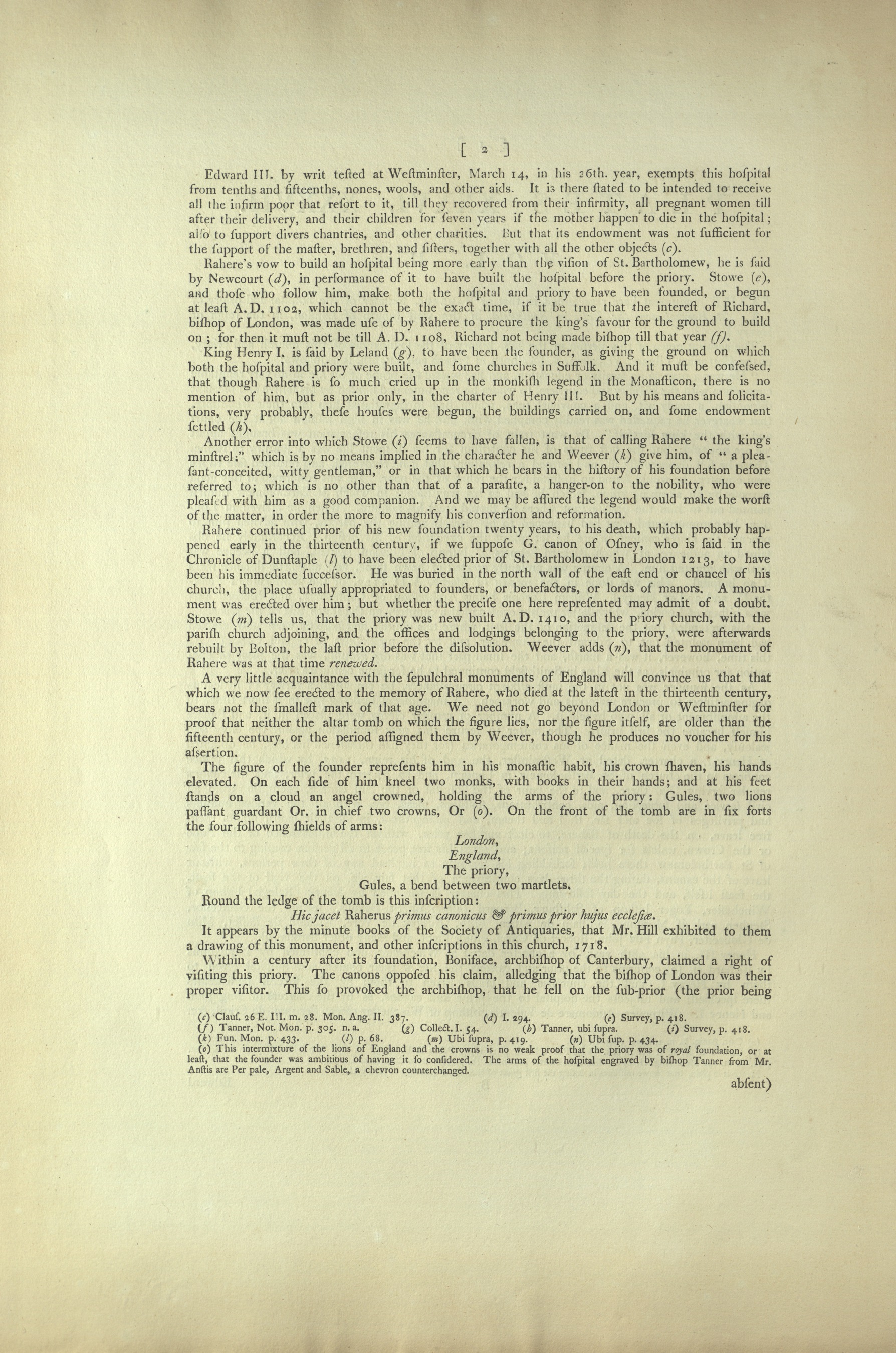
[(Page) 2]
Edward III. by writ teſted at Weſtminſter, March 14, in his 26th year, exempts this hoſpital from tenths and fifteenths, nones, wools, and other aids. It is there ſtated to be intended to receive all the infirm poor that reſort to it, till they are recovered from their infirmity, all pregnant women till after their delivery, and their children for ſeven years if the mother happen to die in the hoſpital;
alſo to ſupport divers chantries, and other charities. But that its endowment was not ſufficient for the ſupport of the maſter, brethren, and ſiſters, together with all the other objects (c).
Rahere’s vow to build an hoſpital being more early than the viſion of St. Bartholomew, he is ſaid by Newcourt (d), in performance of it to have built the hoſpital before the priory. Stowe (e), and thoſe who follow him, make both the hoſpital and priory to have been founded, or begun at leaſt A.D. 1102, which cannot be the exact time, if it be true that the intereſt of Richard, biſhop of London, was made uſe of by Rahere to procure the king’s favor for the ground to build on; for then it muſt not be till A.D. 1108, Richard not being made biſhop till that year (f).
King Henry I. is ſaid by Leland (g), to have been the founder, as giving the ground on which both the hoſpital and priory were built, and ſome churches in Suffolk. And it muſt be confeſsed that though Rahere is ſo much cried up in the monkiſh legend in the Monaſticon, there is no mention of him, but as prior only, in the charter of Henry III. But by his means and ſolicitations, very probably, theſe houſes were begun, the buildings carried on, and ſome endowment ſettled (h).
Another error into which Stowe (i) ſeems to have fallen, is that of calling Rahere “the king's minſtrel:” which is by no means implied in the character he and Weever (k) give him, of “a pleaſant-conceited, witty gentleman,” or in that which he bears in the hiſtory of his foundation before referred to; which is no other than that of a paraſite, a hanger-on to the nobility, who were pleaſed with him as a good companion. And we may be aſſured the legend would make the worſt of the matter, in order the more to magnify his converſion and reformation.
Rahere continued prior of his new foundation twenty years, to his death, which probably happened early in the thirteenth century, if we ſuppoſe G. canon of Ofney, who is ſaid in the Chronicle of Dunſtaple (l) to have been elected prior of St. Bartholomew in London 1213, to have been his immediate ſucceſsor. He was buried in the north wall of the eaſt end or chancel of his church, the place uſually appropriated to founders, or benefactors, or lords of manors. A monument was erected over him; but whether the preciſe one here repreſented may admit of a doubt. Stowe (m) tells us, that the priory was new built A.D. 1410, and the priory church, with the pariſh church adjoining, and the offices and lodgings belonging to the priory, were afterwards rebuilt by Bolton, the laſt prior before the diſſolution. Weever adds (n), that the monument of Rahere was at that time renewed.
A very little acquaintance with the ſepulchral monuments of England will convince us that that which we now ſee erected to the memory of Rahere, who died at the lateſt in the thirteenth century, bears not the ſmalleſt mark of that age. We need that go beyond London or Weſtminſter for proof that neither the altar tomb on which the figure lies, nor the figure itſelf, are older than the 15th century, or the period aſſigned them by Weever, though he produces no voucher for his aſsertion.
The figure of the founder repreſents him in his monaſtic habit, his crown ſhaven, his hands elevated. On each ſide of him kneel two monks, with books in their hands; and at his feet ſtands on a cloud an angel crowned, holding the arms of the priory: Gules, two lions paſſant guardant Or. in chief two crowns, Or. (o). On the front of the tomb are in ſix forts the four following ſhields of arms: London, England, The priory, Gules, a bend between two martlets. Round the ledge of the tomb is the inſcription: Hic jacet Raherus Primus Canonicus primus prior hujus eccleſiæ. [Here lies Raherus, first canon, first prior of this church.]
It appears by the minute books of the Society of Antiquaries, that Mr. Hill exhibited to them a drawing of this monument, and other inſcriptions in this church, 1718.
Within a century after its foundation, Boniface, archbiſhop of Canterbury, claimed a right of viſiting this priory. The cannons oppoſed his claim, alledging that the biſhop of London was their proper viſitor. This ſo provoked the archbiſhop, that he fell on the ſub-prior (the prior being
(c) Clauſ. 26 E. III. m. 28. Mon. Ang. II. 387.
(d) I. 294.
(e) Survey, p. 418.
(f) Tanner, Not. Mon. p. 305. n.a.
(g) Collect. I. 54.
(h) Tanner, ubi ſupra.
(i) Survey, p. 418.
(k) Fun. Mon. p. 433.
(l) p. 68.
(m) Ubi ſupra, p. 419.
(n) Ubi ſup. p. 434.
(o) This intermixture of the lions of England and the crowns is no weak proof that the priory was of royal foundation, or at leaſt, that the founder was ambitious of having it ſo conſidered. The arms of the hoſpital engraved by biſhop Tanner from Mr. Anſtis are Per pale, Argent and Sable, a chevron counterchanged.
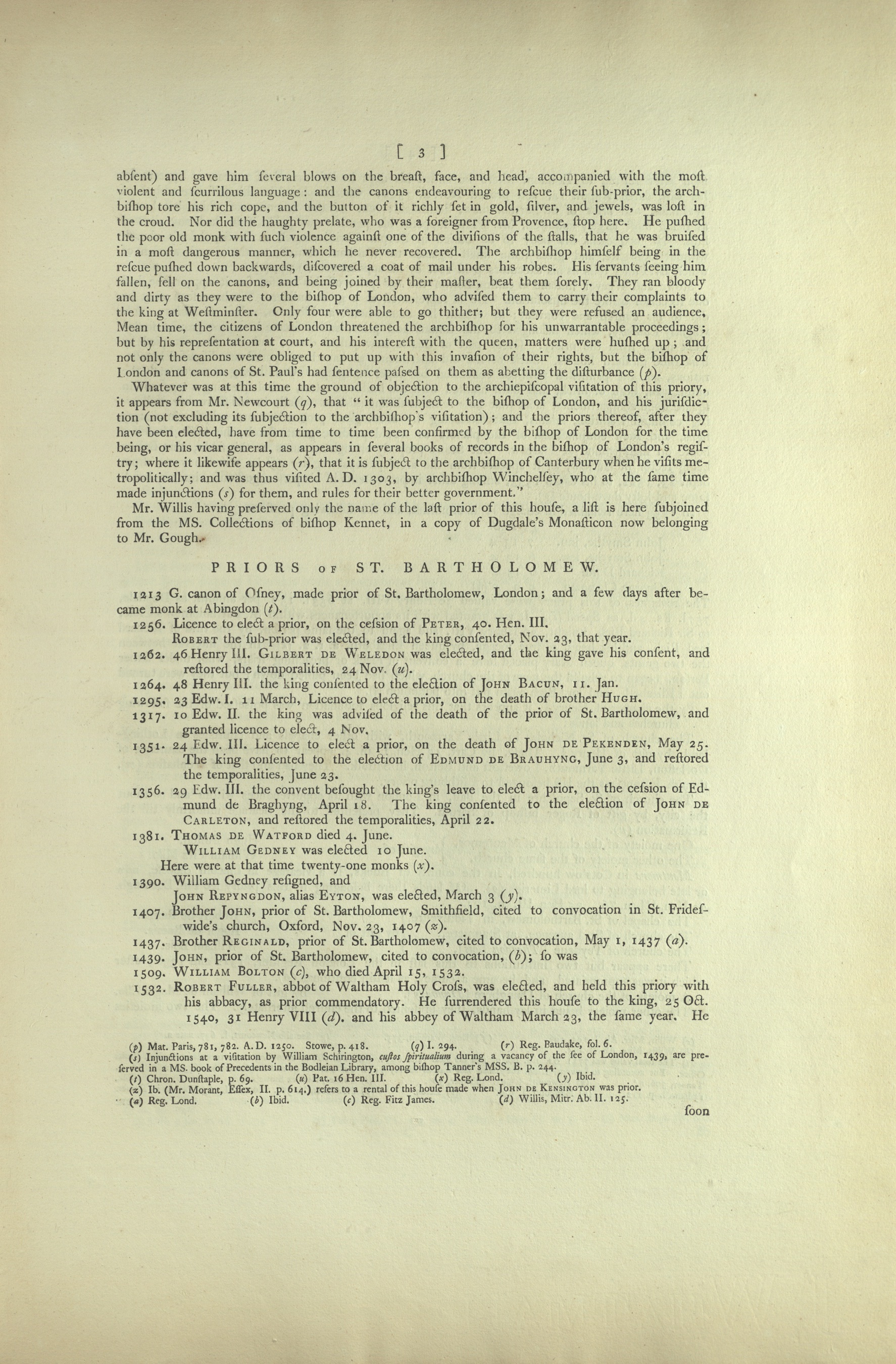
[(Page) 3]
abſent) and gave him ſeveral blows on the breaſt, face, and head, accompanied with the moſt violent and ſcurrilous language: and the canons endeavoring to reſcue their ſub-prior, the archbiſhop tore his rich cope, and the button of it richly ſet in gold, ſilver, and jewels, was loſt in the croud. Nor did the haughty prelate, who was a foreigner from Provence, ſtop here.
He puſhed the poor old monk with ſuch violence againſt one of the diviſions of the ſtalls, that he was bruiſed in a moſt dangerous manner, which he never recovered. The archbiſhop himſelf being in the reſcue puſhed down backwards, diſcovered a coat of mail under his robes. His ſervants ſeeing him fallen, fell on the canons, and being joined by their maſter, beat them ſorely. They ran bloody and dirty as they were to the biſhop of London, who adviſed them to carry their complaints to the king at Weſtminſter. Only four were able to go thither; but they were refuſed an audience. Mean time, the citizens of London threatened the archbiſhop for his unwarrantable proceedings; but by his repreſentation at court, and his intereſt with the queen, matters were huſhed up; and not only the canons were obliged to put up with this invaſion of their rights, but the biſhop of London and canons of St. Paul’s had ſentence paſſed on them as abetting the diſturbance (p).
Whatever was at this time the ground of objection to the archiepiſcopal viſitation of this priory, it appears from Mr. Newcourt (q), that “it was ſubject to the biſhop of London, and his juriſdiction (not excluding it’s ſubjection to the archbiſhop’s viſitation); and the priors thereof, after they have been elected, have from time to time been confirmed by the biſhop of London for the time being, or his vicar general, as appears in ſeveral books of records in the biſhop of London’s regiſtry; where it likewiſe appears (r), that it is ſubject to the archbiſhop of Canterbury when he viſits metropolitically; and was thus viſited A.D. 1303, by archbiſhop Winchelſey, who at the ſame time made injunctions (s) for them, and rules for their better government.”
Mr. Willis having preſerved only the name of the laſt prior of this houſe, a liſt is here ſubjoined from the MS. Collections of Biſhop Kennet, in a copy of Dugdale’s Monaſticon now belonging time Mr. Gough.
PRIORS OF ST. BARTHOLOMEW.
1213 G. canon of Ofney, made prior of St. Bartholomew, London; and a few days after became monk at Abingdon (t).
1256. Licence to elect a prior, on the ceſsion of PETER, 40. Hen. III.
ROBERT the ſub-prior was elected, and the king conſented, Nov. 23, that year.
1262. 46 Henry III. GILBERT DE WELEDON was elected, and the king gave his conſent, and reſtored the temporalities, 24 Nov. (u).
1264. 48 Henry III. the king conſented to the election of JOHN BACUN, 11. Jan.
1295. 23 Edw. I. 11 March, Licence to elect a prior, on the death of brother HUGH.
1317. 10 Edw. II. the king was adviſed of the death of the prior of St. Bartholomew, and granted licence to elect, 4 Nov.
1351. 24 Edw. III. Licence to elect a prior, on the death of JOHN DE PEKENDEN, May 25. The king conſented to the election of EDMUND DE BRAUHYNG, June 3, and reſtored the temporalities, June 23.
1356. 29 Edw. III. the convent beſought the king’s leave to elect a prior, on the ceſsion of Edmund de Braghyng, April 18. The king conſented to the election of JOHN DE CARLETON, and reſtored the temporalities, April 22.
1381. THOMAS DE WATFORD died 4. June.
WILLIAM GEDNEY was elected 10 June.
Here were at the time twenty-one monks (x).
1390. William Gedney reſigned, and
JOHN REPYNGDON, alias EYTON, was elected, March 3 (y).
1407. Brother JOHN, prior of St. Bartholomew, Smithfield, cited to convocation in St. Frideſwide’s church, Oxford, Nov. 23, 1407 (z).
1437. Brother REGINALD, prior of St. Bartholomew, cited to convocation, May 1, 1437 (a).
1439. JOHN, prior of St. Bartholomew, cited to convocation, (b); ſo was
1509. WILLIAM BOLTON (c), who died April 15, 1532.
1532. ROBERT FULLER, abbot of Waltham Holy Croſs, was elected, and held this priory with his abbacy, as prior commendatory. He ſurrendered this houſe to the king, 25 Oct. 1540, 31 Henry VIII (d). and his abbey of Waltham March 23, the ſame year. He
(p) Mar. Paris, 781, 782. A.D. 1250. Stowe, p. 418.
(q) I. 294.
(r) Reg. Paudake, fol. 6.
(s) Injunctions at a viſitation by William Schirington, caſios ſpiritualium during a vacancy of the ſee of London, 1439, are preſerved in a MS. book of Precedents in the Bodleian Library, among biſhop Tanner’s MSS. B. p. 244.
(t) Chron. Dunſtaple, p. 69.
(u) Pat. 16 Hen. III.
(x) Reg. Lond.
(y) Ibid.
(z) Ib. (Mr. Morant, Eſſex, II. p. 614.) refers to a rental of this houſe made when JOHN DE KENSINGTON was prior.
(a) Reg. Lond.
(b) Ibid.
(c) Reg. Fitz James.
(d) Willis, Mitr. Ab. II. 125.
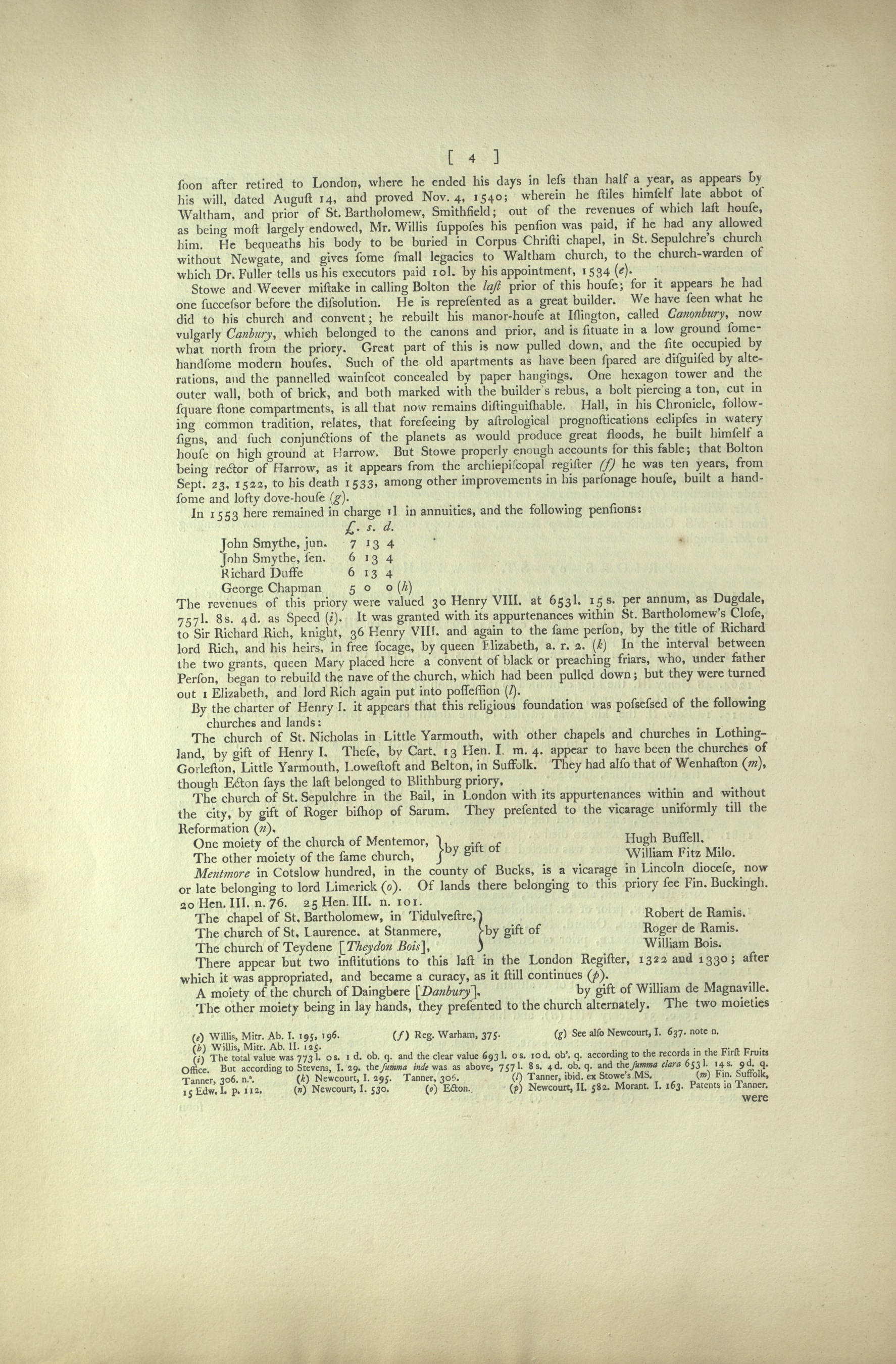
[(Page) 4]
ſoon after he retired to London, where he ended his days in leſs than half a year, as appears by his will, dated Auguſt 14, and proved Nov. 4, 1540; wherein he ſtiles himſelf late abbot of Waltham, and prior of St. Bartholomew, Smithfield; out of the revenues of which laſt houſe, as being moſt largely endowed, Mr. Willis ſuppoſes his penſion was paid, if he had any allowed him.
He bequeaths his body to be buried in Corpus Chriſti chapel, in St. Sepulchre’s church without Newgate, and gives ſome ſmall legacies to Waltham church, to the church-warden of which Dr. Fuller tells us his executors paid 10l. by his appointment, 1534 (e).
Stowe and Weever miſtake in calling Bolton the laſt prior of this houſe; for it appears he had one ſucceſsor before the diſsolution. He is repreſented as a great builder. We have ſeen what he did to his church and convent; he rebuilt his manor-houſe at Iſlington, called Canonbury, now vulgarly Canbury, which belonged to the canons and prior, and is ſituate in a low ground ſomewhat north from the priory. Great part of this is now hold down, and the ſite occupied by handſome modern houſes. Such of the old apartments as have been ſpared are diſguiſed by alterations, and the panelled wainſcot concealed by paper hangings. One hexagon tower and the outer wall, both of brick, and both marked with the builder’s rebus, a bolt piercing a ton, cut in ſquare ſtone compartments, is all that now remains diſtinguiſhable. Hall, in his Chronicle, following common tradition, relates, that foreſeeing by aſtrological prognoſtications eclipſes in watery ſigns, and ſuch conjugations of the planets as would produce great floods, he built himſelf a houſe on high ground at Harrow. But Stowe properly enough accounts for this fable; that Bolton being rector of Harrow, as it appears from the archiepiſcopal regiſter (f) he was ten years, from Sept. 23, 1522, to his death 1533, among other improvements in his parſonage houſe, built a handſome and lofty dove-houſe (g).
In 1553 here remained in charge tl in annuities, and the following penſions:
£. s. d.
John Smythe, jun. 7 13 4
John Smythe, fen. 6 13 4
Richard Duffe 6 13 4
George Chapman 5 0 0 (h)
The revenues of this priory were valued 30 Henry VIII. at 653l. 15s. per annum, as Dugdale, 757l. 8s. 4d. as Speed (i). It was granted with its appurtenances within St. Bartholomew’s Cloſe, to Sir Richard Rich, knight, 36 Henry VIII. and again to the ſame perſon, by the title of Richard lord Rich, and his heirs, in free ſocage, by Queen Elizabeth, a. r. 2. (k) In the interval between the two grants, queen Mary placed here a convent of black or preaching friars, who, under father Perſon, begin to rebuild the nave of the church, which have been pulled down; but they were turned out I Elizabeth, and lord Rich again put into poſſeſſion (l).
By the charter of Henry I. it appears that this religious foundation was poſseſsed of the following churches and lands:
The church of Saint Nicholas in Little Yarmouth, with other chapels and churches in Lothingland, by gift of Henry I. Theſe, by Cart. 13 Hen. I. m. 4. appear to have been the churches of Gorleton, Little Yarmouth, Loweſtoft and Belton, in Suffolk. They had alſo that of Wenhafton (m), though Ecton ſays the laſt belonged to Blithburg priory.
The church of St. Sepulchre in the Bail, in London with its appurtenances within and without the city, by gift of Roger biſhop of Sarum. They preſented to the vicarage uniformly till the Reformation (n).
One moiety of the church of Mentemor, } by gift of Hugh Buffell,
The other moiety of the ſame church, William Fitz Milo.
Mentmore in Cotſlow hundred, in the county of Bucks, is a vicarage in Lincoln dioceſe, now or late belonging to lord Limerick (o). Of lands there belonging to this priory ſee Fin. Buckingh. 20 Hen. III. n. 76. 25 Hen. III. n. 101.
The chapel of St. Bartholomew, in Tidulveſtre, } by gift of Robert de Ramis,
The church of St. Lawrence, at Stanmere, Roger de Ramis,
The church of Teydene [Theydon Bois], William Bois.
There appear but two inſtitutions to this laſt in the London Regiſter, 1322 and 1330; after which it was appropriated, and became a curacy, as it ſtill continues (p).
A moiety of the church of Daingbere [Danbury], by gift of William de Magnaville.
The other moiety being in lay hands, they preſented to the church alternately. The two moieties
(e) Willis, Mitr. Ab. I. 195, 196.
(f) Reg. Warham, 375.
(g) See alſo Newcourt, I. 637. note n.
(h) Willis, Mitr. Ab. II. 125.
(i) The total value was 773l. 0s. 1d. ob. q. and the clear value 693l. 8s. 4d. ob. q. according to the records in the Firſt Fruits Office. But according to Stevens, I. 29. the ſumma inde was as above, 757l. 8s. 4. ob. q. and the ſumma clara 655l. 14s. 9d. q. Tanner, 306. n.
(k) Newcourt, I. 295. Tanner, 306.
(l) Tanner, ibid. ex Stowe’s MS.
(m) Fin. Suffolk, 15 Edw. l. p. 112.
(n) Newcourt, I. 530.
(o) Ecton.
(p) Newcourt, II. 582. Morant. I. 263. Patents in Tanner.
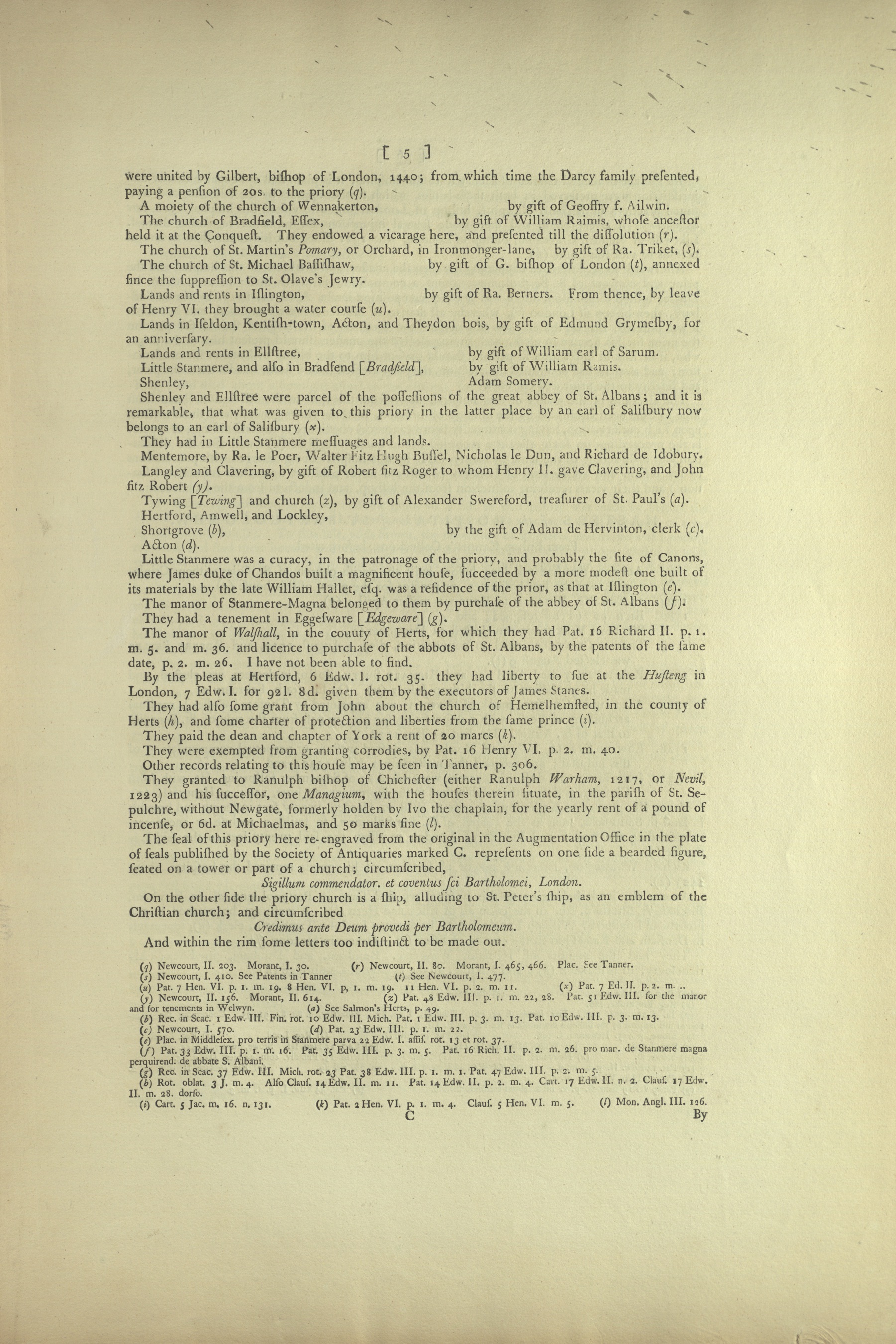
[(Page) 5]
were united by Gilbert, biſhop of London, 1440; from which time the Darcy family preſented, paying a penſion of 20s. to the priory (q).
A moiety of the church of Wennakerton, by gift of Geoffry f. Ailwin.
The church of Bradfield, Eſſex, by gift of William Raimis, whoſe anceſtor held it at the Conqueſt. They endowed a vicarage here, and preſented till the diſſolution (r).
The church of St. Martin’s Pomary, or Orchard, in Ironmonger-lane, by gift of Ra. Triket, (s).
The church of St. Michael Baſſiſhaw, by gift of G. biſhop of London (t), annexed ſince the ſuppreſſion to St. Olave’s Jewry.
Lands and rents in Iſlington, by gift of Ra. Berners. From thence, by leave of Henry VI, they brought a water courſe (u).
Lands in Iſeldon, Kentiſh-town, Acton, and Theydon bois, by gift of Edmund Grymeſby, for an anniverſary.
Lands and rents in Ellſtree, by gift of William earl of Sarum.
Little Stanmere, and alſo in Bradſend [Bradfield], by gift of William Ramis.
Shenley, Adam Somery.
Shenley and Ellſtree were parcel of the poſſeſſions of the great abbey of St. Albans; and it is remarkable, that what was given to this priory in the latter place by an earl of Saliſbury now belongs to an earl of Saliſbury (x).
They had in Little Stanmere meſſuages and lands.
Mentemore, by Ra. le Poer, Walter Fitz Hugh Buſſel, Nicholas le Dun, and Richard de Idobury.
Langley and Clavering, by gift of Robert fitz Roger to whom Henry II. gave Clavering, and John fitz Robert (y).
Tywing [Tewing] and church (z), by gift of Alexander Swereford, treaſurer of St. Paul’s (a).
Hertford, Amwell, and Lockley,
Shortgrove (b), by the gift of Adam de Hervinton, clerk (c).
Acton (d).
Little Stanmere was a curacy, in the patronage of the priory, and probably the ſite of Canons, where James duke of Chandos built a magnificent houſe, ſucceeded by a more modeſt one built of its materials by the late William Hallet, eſq. was a reſidence of the prior, as that at Iſlington (e).
The manor of Stanmere-Magna belonged to them by purchaſe of the Abbey of St. Albans (f).
They had a tenant in Eggeſware [Edgeware] (g).
The manor of Walſhall, in the couuty of Herts, for which they had Pat. 16 Richard II. p. 1. m. 5. and m. 36. and A licence to purchaſe of the abbotts of St. Albans, by the patents of the ſame date, p. 2. m. 26. I have not been able to find.
By the pleas at Hertford, 6 Edw. I. rot. 35. they had liberty to ſue at the Huſteng in London, 7 Edw. I. for 92l. 8d. given them by the executors of James Stanes.
They had alſo ſome grant from John about the church of Hemelhemſted, in the county of Herts (h), and ſome charter of protection and liberties from the ſame prince (i).
They paid the dean and chapter of York a rent of 20 marcs (k).
They were exempted from granting corrodies, by Pat. 16 Henry VI. p. 2. m. 40.
Other records relating to this houſe may be ſeen in Tanner, p. 306.
They granted to Ranulph biſhop of Chicheſter (either Ranulph Warham, 1217, or Nevil, 1223) and his ſucceſſor, one Managium, with the houſes therein ſituate, in the pariſh of St. Sepulchre, without Newgate, formerly holden by Ivo the chaplain, for the yearly rent of a pound of incenſe, or 6d. at Michaelmas, and 50 marks fine (l).
The ſeal of this priory here re-engraved from the original in the Augmentation Office in the plate of ſeals publiſhed by the Society of Antiquaries marked C. repreſents on one ſide a bearded figure, ſeated on a tower or part of a church; circumſcribed,
Sigillum commendator. et coventus ſci Bartholomei, London.
On the other ſide the priory church is a ſhip, alluding to St. Peter’s ſhip, as an emblem of the Chriſtian church; and circumſcribed
Credimus ante Deum provedi per Bartholomeum.
And within the rim ſome letters to indiſtinct to be made out.
(q) Newcourt, II. 203. Morant, I. 30.
(r) Newcourt, II. 80. Morant, I. 465, 466. Plac. See Tanner.
(s) Newcourt, I. 410. See Patents in Tanner
(t) See Newcourt, I. 477.
(u) Pat. 7 Hen. VI. p. 1. m. 19. 8 Hen. VI. p, 1. m. 19. 11 Hen. VI. p. 2. m. 11.
(x) Pat. 7 Edw. p. 2. m ..
(y) Newcourt, II. 156. Morant, II. 614.
(z) Pat. 48 Edw. III. p. 1. m. 22, 28. Pat. 51 Edw. III. for the mator and for tenements in Welwyn.
(a) See Salmon’s Herts, p. 49.
(b) Rec. in Scac. 1 Edw. III. Fin. rot. 10 Edw. III. Mich. Pat. 1 Edw. III. p. 3. m. 13. Pat. 10 Edw. III. p. 3. m. 13.
(c) Newcourt, I. 570.
(d) Pat. 23 Edw. III. p. 1. m. 22.
(e) Plac. in Middleſex. pro terries in Stanmere parva 22 Edw. I. aſſiſ. rot. 13 et rot. 37.
(f) Pat. 33 Edw. III. p. 1. m. 16. Pat. 35 Edw. III. p. 3. m. 5. Pat. 16 Rich. II. p. 2. m. 26. pro mar. de Stanmere magna perquirend de abate S. Albani.
(g) Rec. in Scac. 37 Edw. III. Mich. rot. 23 Pat. 38 Edw. III. p. 1. m. 1. Pat. 47 Edw. III. p. 2. m. 5.
(h) Rot. oblat. 3 J. m. 4. Alſo Clauſ. 14 Edw. II. m. 11. Pat. 14 Edw. II. p. 2. m. 4. Cart. 17 Edw. II. p. 2. Clauſ. 17 Edw. II. m. 28. dorſo.
(i) Cart. 5 Jac. m. 16. n. 131.
(k) Pat. 2 Hen. VI. p. 1. m. 4. Clauſ. 5 Hen. VI. m. 5.
(l) Mon. Angl. III. 126.

[(Page) 6]
By the above recited charter of Henry I. to the hoſpital, it is plain that epiſcopal authority and juriſdiction were preſerved in both theſe houſes, which further appears by the following and continual practices of Richard Newport, biſhop of London (m), who viſited this hoſpital 1318, jure ordinario as it is expreſſed, and then made ſeveral injunctions for the better regulating thereof.
Likewiſe of Stephen Graveſend, biſhop of London, who 1321 iſſued out his commiſſion to ſeveral perſons to viſit this houſe (n).
Afterwards ſome difference happening between the maſter and brethren of this hoſpital and the prior and convent of St. Bartholomew, about a compoſition formally made between them, by Euſtace biſhop of London, there was another compoſition made, April 11, 1373, by Simon Sudbury, then biſhop of London (o), whereby all matters of difference were compoſed, and by which it was ordered, that on the election of a maſter, the brethren of the hoſpital ſhould firſt petition the prior for his licence to elect, and having elected the maſter, ſhould preſent him to the prior, who, if he ſhould find him a fit perſon, ſhould preſent him to the biſhop of London for confirmation; and after he had confirmed the election, the party elected ſhould ſwear obedience to the prior, and fidelity to the prior and convent.
The elections of the matter of this hoſpital, down from this time to the diſſolution, have from time to time been confirmed by the biſhops of London, were their vicars general, and thoſe maſters, upon ſuch confirmation, having continually ſworn canonical obedience to the ſaid biſhops, as appears in the proceedings on ſuch elections recorded in the London regiſters (p): and after the diſſolution and re-founding of the ſame by Henry VIII. by this hoſpital being charged with procurations to the biſhop and archdeacon of London (which are never paid but upon their reſpective viſitations) and their vicars receiving inſtitution from the biſhop, and induction from the archdeacon.
MASTERS of the HOSPITAL of ST. BARTHOLOMEW.
From Biſhop Kennett’s Collections, before cited.
ALFUNE, that had not long before built the pariſh church of St. Giles without Criple-gate, was the firſt hoſpitaler, or proctor for the poor, of this houſe (q).
1324. 17 Edw. III. WILLIAM LE ROUS was maſter April 1 (r).
1386. RICHARD SUTTON reſigned; and
WILLIAM WAKERING was elected 31 December (s).
1509. THOMAS CREVEKER, cited to convocation, died 4 Auguſt, 1510, and ROBERT BEYLEY was elected Auguſt 9 (t).
1516. Robert Beyley died April 23, and RICHARD SMITH, doctor in decrees, was elected, and made his profeſſion to the biſhop July 3 (u). On his death, February 25,
1524. ALEXANDER COLYNS, monk of Daventry, was appointed by Thomas [Wolſey], cardinal archbiſhop of York, with a diſpenſation for him to paſs from the rule of St. Benedict to that of St. Auſtin. He died 15 Jan. 1528.
1528. EDWARD STAPLE, biſhop of Meath, was elected maſter, or perpetual commendatory of this hoſpital; and reſigned this maſterſhip 1 July, 1532; and
1532, JOHN BREERTON, doctor in decrees, was elected 23 of September following. He, with John Chowny, and two others, ſubſcribed to the ſupremacy, 23 June, 1534. 26 Henry VIII (x).
Henry III. granted to Katherine late wife to William Hardell, twenty feet in length and breadth in land in Smithfield, next to the chapel of St. Bartholomew, to build a recluſe or anchorage, commanding the mayor and ſheriffs of London to aſſign the ſaid twenty feet to the ſaid Katherine (y).
Richard Whittington, ſometime mayor of London, of his goods repaired this hoſpital, about 1423 (z).
Among the land belonging to this hoſpital we find ſome in Portpool-lane (a), in Fernham, Birchanger, Stratford, &c. in the counties of Eſſex and Herts (b). A meſſuage bequeathed in the ſuburbs of London by William Langlegh (c); lands given by John Tamworth, clerk (d), tenements in Denham and Rameſdon in the county of Eſſex (e). Others in Hendon (f).
They had the manors of Hatfield, Wakering, Reinham, and Dunham, in Eſſex; Alricheſbury, in Middleſex (g); and Stretely, in the county of Cambridge (h).
(m) Reg. Baudake 40.
(n) Ib. 50.
(o) Reg. Braybroke, 286.
(p) Ib. f. 564. 271. 292. Fitz James, f. 15, 66. Tunſtall, f. 80, 87. Stokeſley, f. 80. 84. 91. 93. Concerning the viſitation of this hoſpital by the biſhop’s comiſſion, ſee Pat. 49 E. III. p. 2. m.
(q) Stowe, p. 415. Newcourt, I. 296.
(r) Pat. 17 Edw. II.
(s) Reg. Lond.
(t) Reg. Lond.
(u) Reg. Lond.
(x) Willis, mitr. Ab. II. 125.
(y) Cart. 11 Hen. III. Stowe, Survey, p. 415.
(z) Stowe, ib.
(a) Newcourt, 108.
(b) Clauſ. 14 Hen. III. m. 15. Fin. div. com. 24 Hen. III. p. 35.
(c) Pat. 14 Edw. II. p. 2. m. 9.
(d) Pat. 48 Edw. III. p. 1. m. 28. vel 29.
(e) Pat. 16 Rich. II. p. 1. m. 2.
(f) Pat. 24 Hen. VI. p. 1. m. 5.
(g) Pat. 9 vel 19 Edw. II. p. 2. m. 8. about common therein.
(h) Pat. 44 Edw. I. p. 1. m. 3.
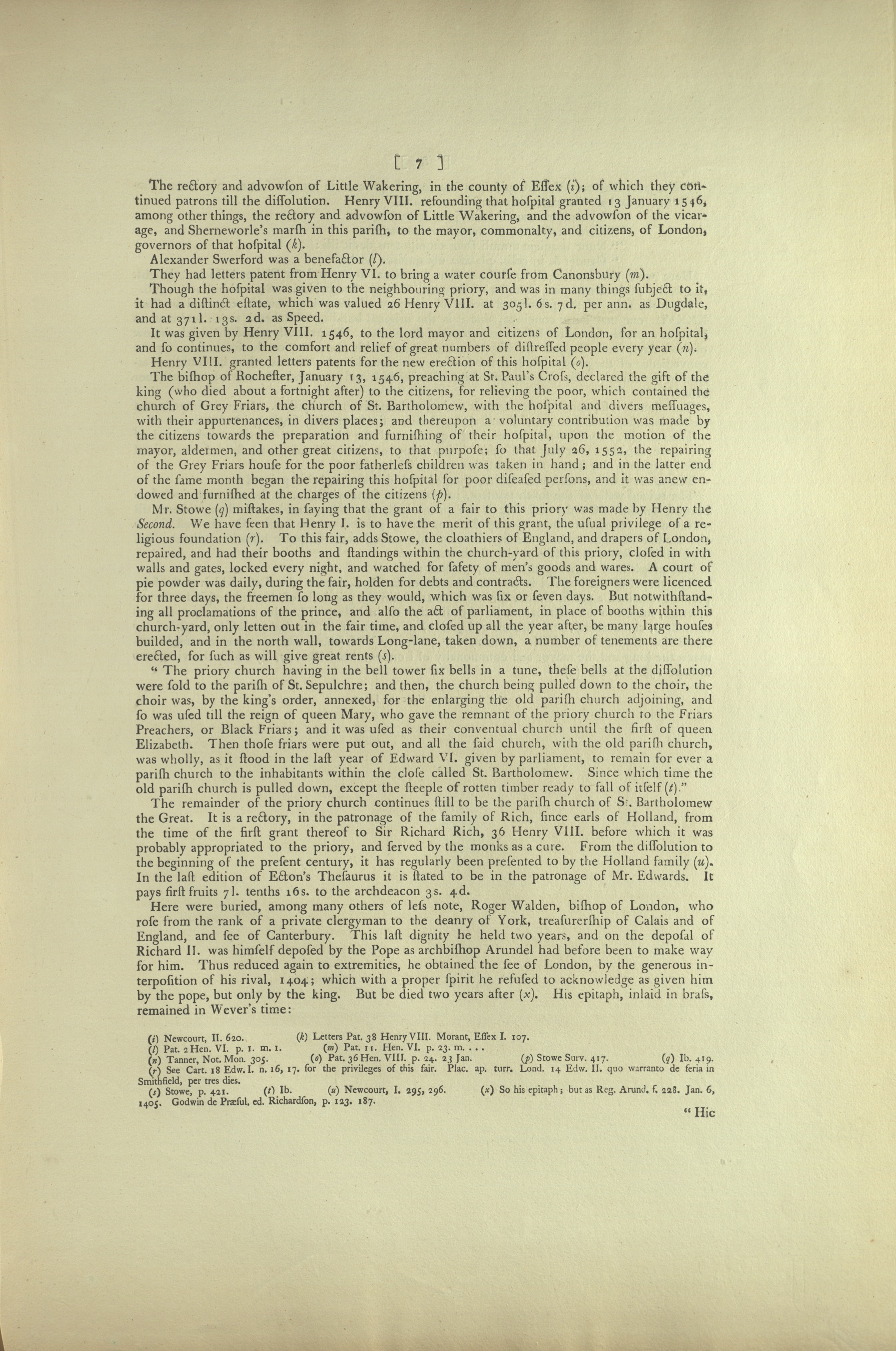
[(Page) 7]
The rectory and advowſon of Little Wakering, in the county of Eſſex (i); of which they continued patrons to the diſſolution. Henry VIII. refounding that hoſpital granted 13 January 1546, among other things, the rectory and advowſon of Little Wakering, and the advowſon of the vicarage, and Sherneworle’s marſh in this pariſh, to the mayor, commonality, and citizens, of London, governors of that hoſpital (k). Alexander Swerford was a benefactor (l).
They had letters patent from Henry VI. to bring a water courſe from Canonſbury (m).
Though the hoſpital was given to the neighboring priory, and was in many things ſubject to it, it had a diſtinct eſtate, which was valued 26 Henry VIII. at 305l. 6s. 7d. per ann. as Dugdale, and at 371l. 13s. 2d. as Speed.
It was given by Henry VIII. 1546, to the lord mayor and citizens of London, for an hoſpital, and ſo continues, to the comfort and relief of great numbers of diſtreſſed people every year (n).
Henry VIII. granted letters patents for the new erection of this hoſpital (o).
The biſhop of Rocheſter, January 13, 1546, preaching at St. Paul’s Croſs, declared the gift of the king (who died about a fortnight after) to the citizens, for relieving the poor, which contained the church of Grey Friars, the church of St. Bartholomew, with the hoſpital and divers meſſuages, with their appurtenances, in divers places; and thereupon a voluntary contribution was made by the citizens towards the preparation and furniſhing of their hoſpital, upon the motion of the mayor, alderman, and other great citizens, to that purpoſe; ſo that July 26, 1552, the repairing of the Grey Friars houſe for the poor fatherleſs children was taken in hand; and in the latter end of the ſame month begin the repairing this hoſpital for poor diſeaſed perſons, and it was anew endowed and furniſhed at the charges of the citizens (p).
Mr. Stowe (q) miſtakes, in ſaying that the grant of a fair to this priory was made by Henry the Second. We have ſeen that Henry I. is to have the merit of this grant, the uſual privilege of a religious foundation (r). To this fair, adds Stowe, the cloathiers of England, and drapers of London, repaired, and had their booths and ſtandings within the church-yard of this priory, cloſed in with walls and gates, locked every night, and watched for ſafety of men’s goods and wares. A court of pie powder was daily, during the fair, holden for debts and contracts. The foreigners were licenced for three days, the freemen ſo long as they would, which was ſix or ſeven days. But notwithſtanding all proclamations of the prince, and alſo the act of parliament, in place of booths within this church-yard, only letten out in the fair time, and cloſed up all the year after, be many large houſes builded, and in the north wall, towards Long-lane, taken down, a number of tenements are there erected, for ſuch as will give great rents (s).
“The priory church having in the bell tower ſix bells in a tune, theſe bells at the diſſolution were ſold to the pariſh of St. Sepulchre; And then, the church being pulled down to the choir, the choir was, by the king’s order, annexed, for the enlarging the old pariſh church adjoining , and ſo was uſed till the reign of queen Mary, who gave the remnant of the priory church to the Friars Preachers, or Black Friars; and it was uſed as their conventual church until the firſt of queen Elizabeth. Then thoſe friars were put out, and all the ſaid church, with the old pariſh church, was wholly, as it ſtood in the laſt year of Edward VI. given by parliament, to remain for ever a pariſh church to the inhabitants within the cloſe called St. Bartholomew. Since which time the old pariſh church is pulled down, except the ſteeple of rotten timber ready to fall of itſelf (t).”
The remainder of the priory church continues ſtill to be the pariſh church of St. Bartholomew the Great. It is a rectory, in the patronage of the family of Rich, ſince earls of Holland, from the time of the firſt grant thereof to Sir Richard Rich, 36 Henry VIII. before which it was probably appropriated to the priory, and ſerved by the monks as a cure. From the diſſolution to the beginning of the preſent century, it has regularly been preſented to by the Holland family (u). In the laſt edition of Ecton’s Theſaurus it is ſtated to be in the patronage of Mr. Edwards. It pays firſt fruits 7l. tenths 16s. to the archdeacon 3s. 4d.
Here were buried, among many others of leſs note, Roger Walden, biſhop of London, who roſe from the rank of a private clergyman to the deanry of York, treaſurerſhip of Calais and of England, and ſee of Canterbury. This laſt dignity he held two years, and on the depoſal of Richard II. was himſelf depoſed by the Pope as archbiſhop Arundel had before been to make way for him. Thus reduced again to extremities, he obtained the ſee of London, by the generous interpoſition of his rival, 1404; which with a proper ſpirit he refuſed to acknowledge as given him by the pope, but only by the king. But he died two years after (x). His epitaph, inlaid in braſs, remained in Wever’s time:
(i) Newcourt, II. 620.
(k) Letters Pat. 38 Henry VIII. Morant, Eſſex I. 107.
(l) Pat. 2 Hen. VI. p. 1. m. 1.
(m) Pat. 11 Hen. VI. p. 23. m. …
(n) Tanner, Not. Mon. 305.
(o) Pat. 36 Hen. VIII. p. 24. 23 Jan.
(p) Stowe Surv. 417.
(q) Ib. 419.
(r) See Cart. 18 Edw. I. n. 16, 17, for the privileges of this fair. Plac. ap. turr. Lond. 14 Edw. II. quo warranto de feria in Smithfield, per tres dies.
(s) Stowe, p. 421.
(t) Ib.
(u) Newcourt, I. 295, 296.
(x) So his epitaph; but as Reg. Arund. f. 228. Jan. 6, 1405. Godwin de Præful, ed. Richardſon, p. 123. 187.
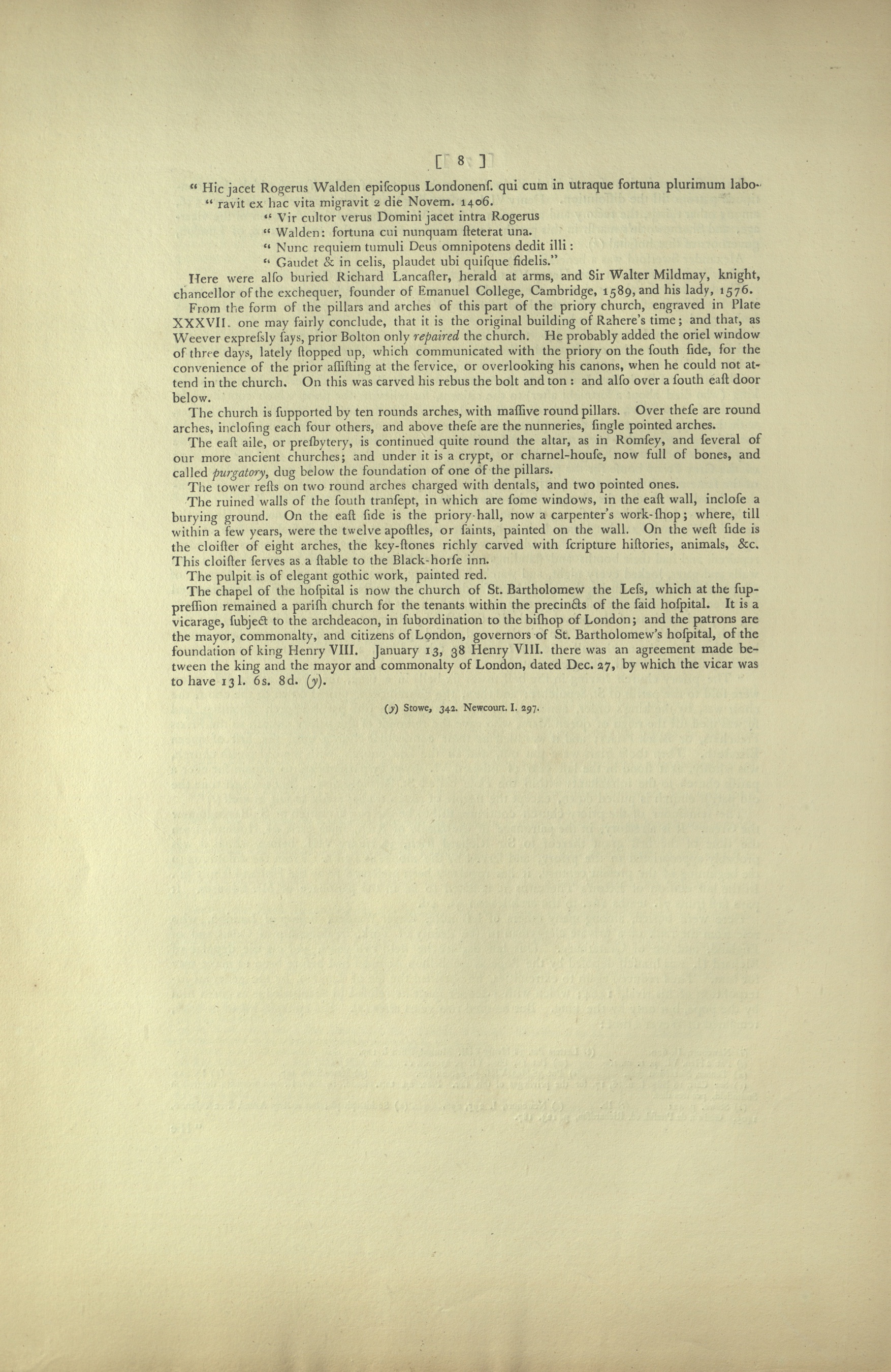
[(Page) 8]
“Hic jacet Rogerus Walden epiſcopus Londonens. qui cum in utraque fortuna plurimum laboravit ex hac vita migravit 2 die Novem. 1406.
“Vir cultor verus Domini jacet intra Rogerus
“Walden: fortuna cui nunquam ſteterat una.
“Nunc requiem tumuli Deus omnipotens dedit illi:
“Gaudet & in celis, plaudit ubi quiſque fidelis.”
Here were alſo buried Richard Lancaſter, herald at arms, and Sir Walter Mildmay, knight, chancellor of the exchequer, founder of Emanuel College, Cambridge, 1589, and his lady, 1576.
From the form of the pillars and arches of this part of the priory church, engraved in Plate XXXVII, one may fairly conclude, that it is the original building of Rahere’s time; and that, as Weaver expreſsly ſays, prior Bolton only repaired the church. He probably added the oriel window of three days, lately ſtopped up, which communicated with the priory on the ſouth ſide, for the convenience of the prior aſſiſting at the ſervice, or overlooking his canons, when he could not attend the church. On this was carved his rebus the bolt and ton: and alſo over a ſouth eaſt door below.
The church is ſupported by ten rounds arches, with maſſive round pillars. Over theſe are round arches, incloſing each four others, and above theſe are the nunneries, ſingle pointed arches.
The eaſt aiſle, or preſbytery, is continued quite round the altar, as in Romſey, and ſeveral of our more ancient churches; and under it is a crypt, or charnel-houſe, now full of bones, and called purgatory, dug below the foundation of one of the pillars.
The tower reſts on two round arches charged with dentals, and two pointed ones.
The ruined walls of the ſouth tranſept, in which are ſome windows, in the eaſt wall, incloſe a burying ground. On the eaſt ſide is the priory hall, now a carpenter’s work-ſhop; where, till within a few years, were the twelve apoſtles, or ſaints, painted on the wall. On the weſt ſide is the cloiſter of eight arches, the key-ſtones richly carved with ſcripture hiſtories, animals, &c. This cloiſter ſerves as a ſtable to the Black-horſe inn.
The pulpit is of elegant gothic work, painted red.
The chapel of the hoſpital is now the church of St. Bartholomew the Leſs, which at the ſuppreſſion remained a pariſh church for the tenants within the precincts of the ſaid hoſpital. It is a vicarage, ſubject to the archdeacon, in ſubordination to the biſhop of London; and the patrons are the mayor, commonality, and citizens of London, governors of St. Bartholomew’s hoſpital, of the foundation of king Henry VIII. January 13, 38 Henry VIII. There was an agreement made between the king and the mayor and commonality of London, dated Dec. 27, by which the vicar was to have 13 l. 6 s. 8 d. (y).
(y) Stowe, 342. Newcourt. I. 297.
Translation of the Longer Passages:
Page 8, lines 1-6: Here lies Roger Walden, Bishop of London, who, after toiling much in good and bad fortune, departed this life on the 2nd day of November, 1406. A man, a true servant of the Lord, lies below, Roger Walden, for whom fortune had never remained constant; now Almighty God has granted him the repose of the tomb. He rejoices and in the heavens sings praises where are all the faithful.